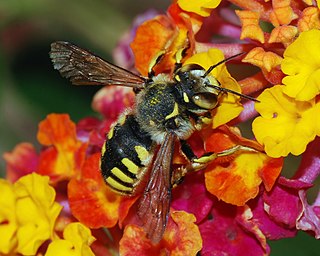
Megachilidae is a cosmopolitan family of mostly solitary bees. Characteristic traits of this family are the restriction of their pollen-carrying structure to the ventral surface of the abdomen, and their typically elongated labrum. Megachilid genera are most commonly known as mason bees and leafcutter bees, reflecting the materials from which they build their nest cells ; a few collect plant or animal hairs and fibers, and are called carder bees, while others use plant resins in nest construction and are correspondingly called resin bees. All species feed on nectar and pollen, but a few are kleptoparasites, feeding on pollen collected by other megachilid bees. Parasitic species do not possess scopae. The motion of Megachilidae in the reproductive structures of flowers is energetic and swimming-like; this agitation releases large amounts of pollen.

Anthidium is a genus of bees often called carder or potter bees, who use conifer resin, plant hairs, mud, or a mix of them to build nests. They are in the family Megachilidae which is cosmopolitan in distribution and made up of species that are mostly solitary bees with pollen-carrying scopa that are only located on the ventral surface of the abdomen. Other bee families have the pollen-carrying structures on the hind legs. Typically species of Anthidium feed their brood on pollen and nectar from plants. Anthidium florentinum is distinguished from most of its relatives by yellow or brick-red thoracic bands. They fly all summer and make the nests in holes in the ground, walls or trees, with hairs plucked from plants.

Anthidium utahense is a species of bee in the family Megachilidae, the leaf-cutter, carder, or mason bees.
Anthidium soni is a species of bee in the family Megachilidae, the leaf-cutter, carder, or mason bees.
Anthidium severini is a species of bee in the family Megachilidae, the leaf-cutter, carder, or mason bees.
Anthidium rubripes is a species of bee in the family Megachilidae, the leaf-cutter, carder, or mason bees.
Anthidium rodriguezi is a species of bee in the family Megachilidae, the leaf-cutter, carder, or mason bees.
Anthidium pontis is a species of bee in the family Megachilidae, the leaf-cutter, carder, or mason bees.

Anthidium maculifrons is a species of bee in the family Megachilidae, the leaf-cutter, carder, or mason bees.

Anthidium loti is a Palearctic species of bee in the family Megachilidae, the leaf-cutter, carder, or mason bees.
Anthidium latum is a species of bee in the family Megachilidae, the leaf-cutter, carder, or mason bees.
Anthidium gayi is a species of bee in the family Megachilidae, the leaf-cutter, carder, or mason bees.
Anthidium funereum is a species of bee in the family Megachilidae, the leaf-cutter, carder, or mason bees.
Anthidium edwardsii is a species of bee in the family Megachilidae, the leaf-cutter, carder, or mason bees.
Anthidium cordiforme is a diurnal species of winged bee in the family Megachilidae, known as the leafcutting bees. They were first classified by Friese in 1922. The bee is bilaterally symmetric from head to tail, and is holometabolous.
Anthidium chubuti is a species of bee in the family Megachilidae, the leaf-cutter, carder, or mason bees.
Anthidium albitarse is a species of bee in the family Megachilidae, the leaf-cutter, carder, or mason bees.
Anthidium akermani is a species of bee in the family Megachilidae, the leaf-cutter, carder, or mason bees.
Anthidium afghanistanicum is a species of bee in the family Megachilidae, the leaf-cutter, carder, or mason bees.
Anthidium tesselatum is a species of bee in the family Megachilidae, the leaf-cutter, carder, or mason bees.




